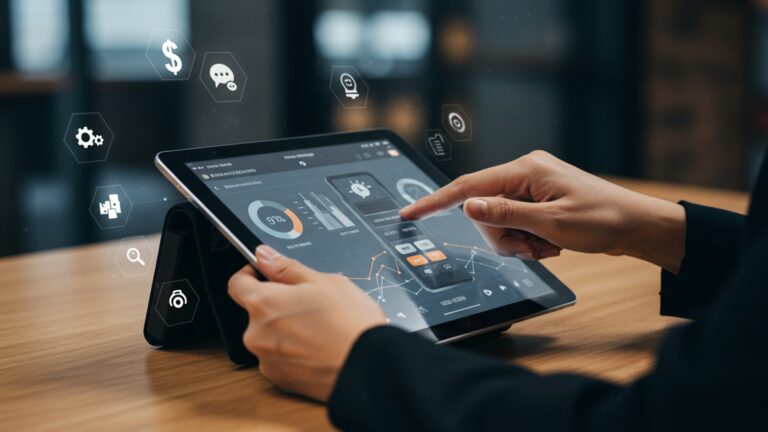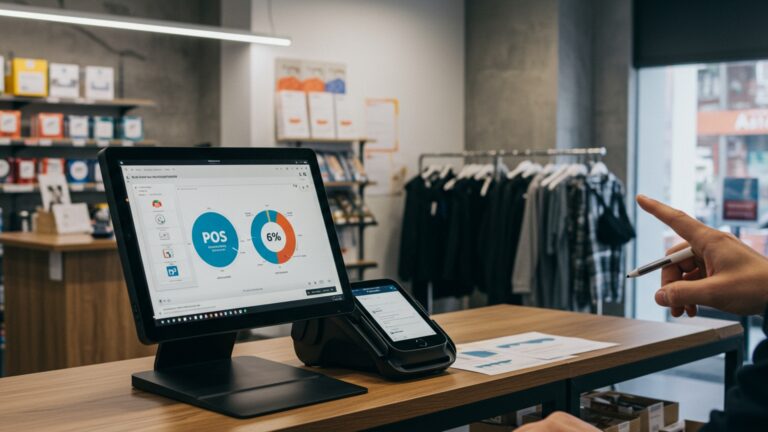A Practical Guide How Mobile POS Software Enhances Customer Service
Modern consumers demand seamless and personalized service, pushing businesses to innovate beyond static transaction points. Mobile POS software emerges as a critical enabler, transforming customer interactions from mere transactions into engaging experiences. This technology empowers staff to provide real-time assistance, process orders tableside in hospitality, or expedite sales on the retail floor, dramatically reducing wait times and friction. With integrated features like instant inventory checks and secure contactless payment options, mobile POS systems not only streamline operations but also foster deeper customer relationships by delivering efficient, informed. highly personalized service directly where it’s needed most, meeting the contemporary demand for speed and convenience.

Understanding Mobile POS Software: A Foundation for Enhanced Service
In today’s fast-paced retail and hospitality environments, the traditional fixed point-of-sale (POS) system is increasingly being complemented, if not replaced, by more agile solutions. Mobile POS (mPOS) software represents a significant evolution in transaction processing, fundamentally reshaping how businesses interact with their customers. At its core, mobile POS software is an application that runs on portable devices like smartphones or tablets, transforming them into full-fledged cash registers. This technology allows businesses to process sales, manage inventory. access customer data from virtually anywhere within their premises or even on the go.
The key components typically include:
- A Mobile Device
- Mobile POS Software Application
- Card Reader
- Optional Peripherals
Usually an iOS or Android smartphone or tablet, serving as the primary interface.
The dedicated app that facilitates all POS functionalities.
Often a small, attachable device (like a dongle or a standalone unit) that processes credit and debit card payments, including EMV chip and contactless (NFC) options.
Portable receipt printers, barcode scanners. cash drawers that can connect wirelessly via Bluetooth.
Unlike its stationary predecessors, mobile POS software offers unparalleled flexibility, enabling staff to move freely, engage with customers on the sales floor. complete transactions without being tethered to a counter. This mobility is not merely a convenience; it is a strategic advantage that directly contributes to a more responsive and satisfying customer experience.
Streamlining Transactions and Reducing Wait Times
One of the most immediate and impactful ways mobile POS software enhances customer service is by dramatically streamlining the transaction process and significantly reducing customer wait times. In retail, long queues are a common source of frustration and a primary reason for abandoned purchases. Mobile POS empowers staff to “line bust” by processing sales directly on the floor, rather than forcing customers to wait at a central checkout.
Consider a bustling coffee shop during the morning rush. Instead of a single cashier struggling to keep up, staff equipped with mobile POS software can take orders and payments directly from customers waiting in line. This not only speeds up service but also transforms a potentially negative waiting experience into a more engaging interaction. Similarly, in restaurants, table-side ordering and payment through mobile POS devices eliminate the need for servers to run back and forth to a stationary terminal, allowing them to focus more on guest needs and turn tables faster.
According to industry analysis, businesses adopting mobile POS solutions often report a noticeable decrease in transaction times, sometimes by as much as 30-50%. This efficiency directly translates into higher customer satisfaction and a more pleasant shopping or dining experience. For instance, a specialty retail chain observed a 20% reduction in customer complaints related to checkout wait times after deploying mobile POS software across its stores, citing the ability to process payments anywhere as a key factor.
Personalized Customer Interactions and Data-Driven Insights
Beyond speed, mobile POS software empowers employees with real-time customer data, enabling highly personalized interactions that were once the exclusive domain of high-end concierge services. When an associate is equipped with a mobile device running the POS application, they can instantly access a customer’s purchase history, loyalty program status, past preferences. even notes from previous interactions. This data allows staff to offer tailored recommendations, acknowledge loyalty. build genuine rapport.
Imagine a scenario in a fashion boutique: A returning customer expresses interest in a new line of dresses. With mobile POS software, the sales associate can quickly pull up their past purchases, identify their preferred brands, sizes. styles. then recommend items that align with their taste. “I see you’ve previously purchased our ‘Elegance’ line in blue; based on that, I think you’ll love this new ‘Serenity’ dress,” an associate might say. This level of personalized service makes customers feel valued and understood, significantly enhancing their shopping experience and fostering brand loyalty.
Moreover, integration with Customer Relationship Management (CRM) systems means that every interaction and purchase can update customer profiles in real-time. This creates a continuous feedback loop that refines future interactions and marketing efforts. The ability to quickly look up product availability in other stores or online, right from the sales floor, also prevents lost sales and improves the customer journey.
Empowering Staff for Superior Service Delivery
The true power of mobile POS software lies in its ability to empower front-line staff, transforming them from mere transaction processors into informed and agile customer service representatives. With a mobile POS device in hand, employees gain immediate access to critical business data that would typically require them to leave the customer’s side and go to a back office or a fixed terminal.
Key ways staff are empowered include:
- Real-time Inventory Access
- Comprehensive Product insights
- Flexible Returns and Exchanges
- Gift Card and Loyalty Program Management
A customer asks if an item is available in a different size or color. Instead of saying, “Let me go check,” an employee can instantly verify stock levels across the store or even other locations using their mobile device. If an item is out of stock, they can offer to order it for home delivery directly.
Staff can pull up detailed product descriptions, specifications, customer reviews. even demonstration videos on the spot. This helps them confidently answer questions and cross-sell or up-sell relevant items.
Processing returns or exchanges no longer requires a trip to a dedicated customer service desk. These operations can be handled efficiently, often on the sales floor, reducing friction for the customer.
Employees can issue new gift cards, check balances, or enroll customers in loyalty programs seamlessly, anywhere in the store.
This level of empowerment translates into a more informed, efficient. responsive staff, directly elevating the quality of customer service. A well-trained employee utilizing mobile POS software can resolve issues, provide details. complete transactions with unprecedented speed and accuracy, leading to higher customer satisfaction and a more positive perception of the business.
Enhanced Flexibility and Omnichannel Experience
The inherent mobility of mobile POS software provides businesses with unprecedented operational flexibility, which in turn significantly enhances the omnichannel customer experience. An omnichannel strategy aims to provide a seamless and consistent customer journey across all touchpoints, whether online, in-store, or through mobile interactions.
Consider the following applications:
- Pop-Up Shops and Events
- Field Sales and Home Services
- Click-and-Collect Fulfillment
Businesses can easily set up temporary retail locations at festivals, trade shows, or seasonal markets, offering the same professional checkout experience as a brick-and-mortar store. This expands their reach and convenience for customers.
Technicians or sales representatives working off-site can process payments and issue invoices immediately upon service completion, enhancing professionalism and customer trust.
When a customer places an order online for in-store pickup, staff can use mobile POS software to quickly locate the item, verify the order. complete the handoff, often on the sales floor, bypassing traditional checkout lines.
This flexibility ensures that customer service remains consistent and high-quality, regardless of the purchasing channel or location. A customer who starts their journey online can smoothly transition to an in-store pickup, with staff having all the necessary order details at their fingertips via mobile POS software. This continuity is crucial in building a strong, reliable brand image.
To illustrate the contrast, consider a brief comparison between traditional fixed POS systems and mobile POS in terms of flexibility and customer experience:
| Feature | Traditional Fixed POS | Mobile POS Software |
|---|---|---|
| Location of Transaction | Confined to a fixed counter | Anywhere on premises or off-site |
| Customer Engagement | Limited to counter interaction | On-the-floor, personalized interaction |
| Line Management | Prone to long queues | “Line busting” capability, reduces wait times |
| Inventory/Data Access | Requires staff to leave customer | Real-time access at customer’s side |
| Event/Pop-up Readiness | Challenging and costly to deploy | Highly portable, quick setup |
| Omnichannel Integration | Often siloed, less seamless | Naturally facilitates seamless transitions |
Security and Reliability: Building Customer Trust
In an era where data breaches are a growing concern, the security and reliability of payment systems are paramount to building and maintaining customer trust. Mobile POS software, when properly implemented, offers robust security features designed to protect sensitive customer insights and ensure reliable transaction processing. This directly contributes to enhanced customer service by providing peace of mind and preventing potential issues.
Key security features typically include:
- End-to-End Encryption
- PCI DSS Compliance
- Tokenization
- Cloud-Based Data Backup
Payment data is encrypted from the moment it is swiped, dipped, or tapped on the card reader until it reaches the payment processor, minimizing the risk of interception.
Reputable mobile POS software providers adhere to the Payment Card Industry Data Security Standard (PCI DSS), a set of security standards designed to ensure that all companies that process, store, or transmit credit card details maintain a secure environment.
Instead of storing actual card numbers, many systems use tokenization, replacing sensitive data with a unique, non-sensitive identifier (token). This makes the data useless to unauthorized parties if a breach were to occur.
Transaction data and business records are typically stored securely in the cloud, offering redundancy and protection against local hardware failures. This ensures business continuity and prevents loss of customer purchase history.
From a customer’s perspective, knowing their payment details is handled securely instills confidence. Transparent and secure processing, often indicated by visible security logos or clear communication from staff, reinforces a positive brand image. For example, a restaurant using mobile POS software to process payments table-side can confidently assure customers that their card never leaves their sight and that the transaction is encrypted, fostering a higher degree of trust compared to older methods where cards might be taken to a back terminal.
Overcoming Challenges and Best Practices for Implementation
While mobile POS software offers significant advantages, successful implementation requires careful planning to overcome potential challenges and maximize its customer service benefits. Addressing these proactively ensures a smooth transition and optimal performance.
Common challenges and corresponding best practices include:
- Connectivity Issues
- Best Practice
- Battery Life Management
- Best Practice
- Staff Training and Adoption
- Best Practice
- Hardware Selection and Maintenance
- Best Practice
- Integration with Existing Systems
- Best Practice
Mobile POS relies heavily on stable Wi-Fi or cellular data.
Invest in a robust, business-grade Wi-Fi network with ample coverage throughout the operational area. Consider backup cellular hotspots for critical areas or off-site events.
Mobile devices need to stay charged throughout shifts.
Provide charging stations, ensure devices are fully charged before shifts. consider purchasing extra battery packs or extended-life devices for long operating hours.
Employees need to be comfortable and proficient with the new technology.
Conduct comprehensive training sessions that cover not just how to use the mobile POS software. also how its features enhance customer interaction. Emphasize the benefits for both staff and customers. Run pilot programs in select areas to gather feedback before a full rollout.
Choosing the right devices and ensuring they are well-maintained.
Select durable, user-friendly devices and card readers. Establish a clear maintenance schedule and protocols for troubleshooting common issues. Ensure adequate spare devices are available.
Ensuring the mobile POS works seamlessly with inventory, CRM. accounting software.
Choose mobile POS software that offers robust API integrations or pre-built connectors with your existing business tools. Test all integrations thoroughly before deployment to prevent data discrepancies.
By thoughtfully planning for these aspects, businesses can fully leverage the power of mobile POS software to deliver an exceptional, modern customer experience that drives loyalty and growth. The investment in the right technology and proper implementation yields significant returns in customer satisfaction and operational efficiency.
Conclusion
Mobile POS software isn’t merely a technological upgrade; it’s a strategic imperative for redefining customer service in today’s fast-paced market. Imagine a busy pop-up shop where transactions are processed instantly, or a restaurant where servers take orders and payments tableside, freeing them to engage more meaningfully with guests. I’ve personally witnessed how this immediacy and flexibility, a key aspect of seamless mobile POS implementation, transforms customer interactions from transactional to truly engaging. My personal tip? Don’t just implement; empower. Train your staff to fully utilize features like real-time inventory lookups and personalized recommendations, turning every interaction into an opportunity for delight. This proactive approach, a current trend I call “situational service,” ensures customers feel valued and understood, avoiding frustrating delays or stock disappointments. By embracing mobile POS, you’re not just speeding up checkouts; you’re cultivating loyalty and building a resilient, customer-centric business ready for tomorrow’s demands.
More Articles
Unleash Business Mobility How to Implement Mobile POS Software Solutions Seamlessly
A Complete Guide How to comprehend and Use Essential POS Software Features
Future Proof Your Business How to Leverage Cloud Based POS Software Benefits
Simplify Your Transactions How to Master POS Billing Software for Accuracy
Elevate Your Restaurant How to Choose the Right POS Software for Success
FAQs
How does mobile POS actually make customer service better?
Mobile POS lets staff serve customers right where they are, cutting down on lines and waiting times. It means faster checkouts and more personalized interactions, as employees aren’t tied to a traditional counter.
Can mobile POS help staff answer customer questions more easily?
Absolutely. With a mobile device, staff can instantly check product details, inventory levels, or customer purchase history on the spot, providing accurate insights without leaving the customer’s side.
What about speeding up transactions? Is that a big benefit?
Yes, it’s a huge benefit! Mobile POS systems allow for quick payment processing from anywhere in the store, significantly reducing checkout queues and making the entire buying experience smoother and faster for the customer.
Does mobile POS allow for more personalized service?
Definitely. By having access to customer profiles and past purchases on their mobile device, staff can offer tailored recommendations, remember preferences. create a more personal and memorable shopping experience.
How does it handle returns or exchanges away from the main counter?
Mobile POS systems are designed for flexibility. Staff can process returns, exchanges, or even issue store credit directly from the mobile device, making these common tasks much more convenient for both the customer and the business.
Is it only for big retail stores, or can smaller businesses use it too?
Mobile POS is incredibly versatile and beneficial for businesses of all sizes, from small boutiques and cafes to large retail chains. It empowers any business to offer a more modern and efficient customer service experience.
What if there’s an issue like an item being out of stock? How does mobile POS help then?
If an item is out of stock, staff can quickly check inventory at other locations, order it for delivery, or suggest alternative products right from their mobile device, preventing customer disappointment and potentially saving a sale.




